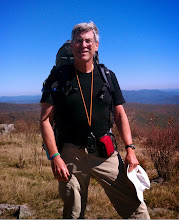Last Friday, I had the day off and it was going to be a little cooler in the mountains, so I headed to Shenandoah National Park to hike the Rose River Falls loop - actually, more of a lollipop than a loop, strictly speaking. It is 6.5 miles and passes by two nice waterfalls: Dark Hollows and Rose River. It's my first hike back up there since running into the bear, and I carried bear spray with me this time, since I was alone.
This hike is a good workout, and as I inexplicably forgot my trekking poles at home, it was harder than usual on my knees and hips, especially the steep downhill sections. And my right ankle still hurts a lot, so I just went at my own pace and did the best I could. I would have held a group up for sure. Here is a track of the loop, arrows showing that I hiked counter-clockwise. The Rose River Falls is marked by a purple star.
Other than the waterfalls, there is not a whole lot of scenery on the hike - it is mainly a walk in the woods. I kept alert for wildlife, and saw a number of animals of the smaller, less spectacular types. I thought of doing a "What am I?" for a change, but the animals that I saw were small and hard to identify.
Here are some photos along the way of my trek, starting with the first hints of fall:
I am not sure what this flowering shrub is, but I call it pretty:
Maybe not as pretty is this orb weaver. I don't know the species, but its rear legs reminded me of candy canes.
I felt really bad for this baby cedar waxwing along the side of the trail. It should be in a nest with parents. I hope very much that its parents were around somewhere, but saw no sign of them.
This is Dark Hollow Falls. It is only about 3/4 mile from the trail head, and you have to drop 500 feet from there to get here.
I don't know if this waterfall has a name or not. It was a short way below Dark Hollow Falls.
This little fellow is a white-spotted slimy salamander.
There are two parts to the Rose River Falls. The Upper Falls, shown here, drops about 25 feet. The light was not right for a great photo. See the log in the upper left? I watched a young man walk out on it, rocks behind him and shallow pool in front, and dive in. I was convinced that he would break his neck, because the pool could not be five or six feet deep at its deepest spot. But he was okay. The Lower Falls drops about 40 feet but is supposed to be quite steep and dangerous to reach, so I passed.
After a sharp climb from the falls, I reached a mellow woods road that dropped gradually for a mile or so back to just below Dark Hollow Falls. From there, it was the steep slog back to my car.
Along the Dark Hollow Fire Road, I spotted this red admiral, and
this red-spotted purple. (The red spots are not really apparent with this one).
Here is one more wildflower that I need to identify. Pretty!
The last wildlife of the hike was this red-backed salamander.
Great hike! Pretty forests and waterfalls, and lots of interesting animals, even if they were on the small side. I hope that the poor little cedar waxwing will be all right. By the way, it is against the law to collect animals in national parks unless you have a special permit, plus I had no way to carry the little bird safely.
Top 12 Moments in My Racing for a Cure Memories
10 years ago


































